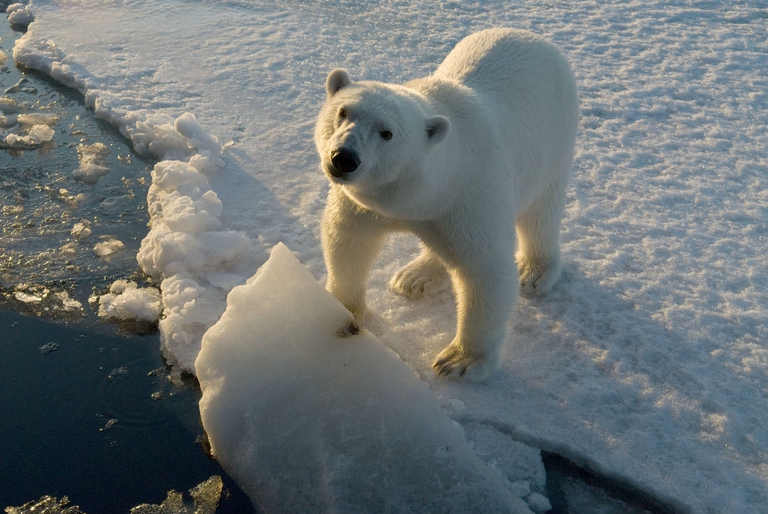
The 26th edition of the United Nations Climate Change Conference, COP26, will be held in Glasgow, Scotland in November 2020. The pre-COP will take place in Milan, Italy.
In 40 years, the Arctic will run out of ice during summer months, as proven by the lowest icecap winter extension ever registered by satellites last March. It is a phenomenon involving half of the Arctic ice. These are some of the effects caused by the on-going climate change, documented by WWF in
In 40 years, the Arctic will run out of ice during summer months, as proven by the lowest icecap winter extension ever registered by satellites last March. It is a phenomenon involving half of the Arctic ice.
These are some of the effects caused by the on-going climate change, documented by WWF in its latest report Ghiaccio Bollente (Boiling Ice), giving a global vision on world’s shrinking ice and its effects on animals and people, based on latest scientific evidences.
“The overview is shocking,” said the association in a note. “2015 is a crucial year for the decisions to be taken by the international community, from the United Nations Sustainable Development Summit to the Conference of the parties (COP21) on climate change to be held in Paris”.
It’s not about catastrophism, but our future. Tens of animal species depend on Arctic, Antarctic and Alpine habitats, places showing alarming signals. The report shows that “in absence of ice, two third of polar bears could disappear by 2050, whilst in Antarctica, 75% of the population of the Adélie penguin could be wiped out”. And we will probably see more and more pictures of walruses clumping on coasts due to melting arctic sea ice.
“In mountainous areas and Arctic and Antarctic regions, local populations assist frightened to their world changing, and consider climate change a real threat and a possible future nightmare,” said WWF.
However, the problem involves us all, not only people living in cold regions. “Our water resources, climate mitigation, oceans balance, and greenhouse gas emissions depend on world’s ice”. Let’s take into consideration the so called Alpine glaciers: 7 major rivers in India and South East Asia are fed by the glaciers of the Karakorum and Himalaya. This means that 2 billion people, to be added to the current 2 million (source: UN), will be affected by water shortage.
Furthermore, the report shows that “70% of world coasts will undergo changes. 360 million people living in big coastal metropolis will be threatened by rising sea levels and extreme weather conditions”. The islands in the Pacific Ocean are an example: in the archipelago of Kiribati, 2 isles are already submerged, whilst Tuvalu, Samoa, and other isles in the Maldives are at risk.
“We have alternatives to fossil fuels: renewable and clean sources. Together with a rational and efficient use of energy and materials, we can offer new opportunities to all”. Ice is vital for our survival. But it is disappearing. This should be enough to push millions of people to act.
Siamo anche su WhatsApp. Segui il canale ufficiale LifeGate per restare aggiornata, aggiornato sulle ultime notizie e sulle nostre attività.
![]()
Quest'opera è distribuita con Licenza Creative Commons Attribuzione - Non commerciale - Non opere derivate 4.0 Internazionale.
The 26th edition of the United Nations Climate Change Conference, COP26, will be held in Glasgow, Scotland in November 2020. The pre-COP will take place in Milan, Italy.
Thanks to activists, the voice of the world’s peoples resounded through the COP25 like an alarm bell. Governments didn’t reach the results they demanded, but their cries and messages were stronger than ever, reaching even those who weren’t in Madrid.
Climate change poses a risk for millions. However, women are the most vulnerable to its negative consequences: a few simple considerations by the Italian Climate Network help us perceive the global implications of this.
The COP25 ended two days late and with very few steps ahead made. Climate negotiations in 2020 will be an uphill battle as political will clearly seems to be lacking, once again.
The last ten years have been the most “exceptional” and hottest decade ever, with extreme weather hitting people and ecosystems harder and more frequently. 2019 is also on course to becoming the second or third hottest year since records began.
Unite Behind the Science: this was the title of the conference held at the COP25 on 10 December. Greta Thunberg’s presence filled the arena, but this time it was scientists’ turn to speak.
25,000 delegates meet for the COP25 from 2 to 13 December. What can we hope this UN climate change conference, whose venue was changed from Santiago de Chile to Madrid, will achieve?
100 eminent people from all over the world, including Vandana Shiva, Naomi Klein and Noam Chomsky, have signed an open letter after the disappointing results of the COP24. A call-to-arms for climate against world leaders’ indifference.
The outcome of the COP24 in Katowice left many unsatisfied. Greta Thunberg, a young Swedish environmental activist, gave a harsh, heartfelt speech addressing world leaders.








